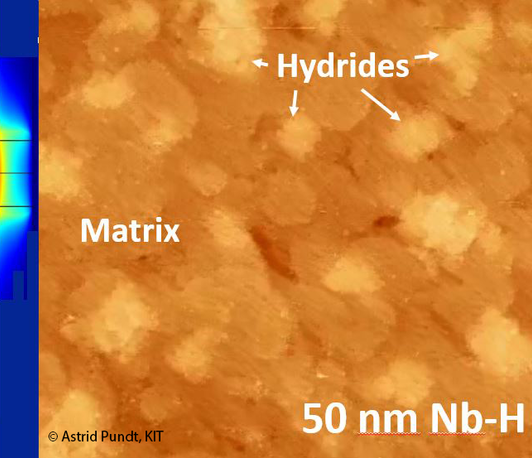H in thin films: size and stress effects on the system thermodynamics and kinetics
MPIE Colloquium
- Date: Apr 23, 2024
- Time: 03:00 PM (Local Time Germany)
- Speaker: Prof. Dr. rer. nat. Astrid Pundt
- Location: Max-Planck-Institut für Eisenforschung GmbH
- Room: Big Seminar Room / Online
- Host: on invitation of Prof. Gerhard Dehm

Register here: https://plan.events.mpg.de/event/200/
Due to its high diffusivity hydrogen atoms alloy
with metals even at room temperature. At this temperature, the materials
microstructure remains rather stable. When the system size is reduced to the
nano-scale, microstructural defects as well as mechanical stress significantly
affect the thermodynamics and kinetics properties of the system.[1-6] Effects will
be demonstrated on Niobium-H and Palladium-H thin films.
Hydrogen absorption in metal systems commonly
leads to lattice expansion. The lateral expansion is hindered when the metal
adheres to a rigid substrate, as for thin films. Consequently, high mechanical
stresses arise upon hydrogen uptake. In theory, these stresses can reach about
-10 GPa for 1 H/M. Usually, metals cannot yield such high stresses and deform
plastically. Thereby, maximum compressive mechanical stress of -2 to -3 GPa is
commonly measured for 100 nm Nb thin films adhered to Sapphire substrates.
It will be shown that phase transformations
change in the coherency state upon film thickness reduction. The coherency state affects the nucleation
and growth behaviour of the hydride phase as well as the kinetics of the phase
transformation.[1] It will be further demonstrated that plastic deformation can
be hindered and even suppressed upon film thickness reduction. In this case the
system behaves purely elastic and ultra-high stress of about -10 GPa can be experimentally
reached.[2] These high mechanical stresses result in changes of the materials
thermodynamics. In the case of Nb-H thin films of less than 8 nm thickness, the
common phase transformation from the α-phase solid solution to the hydride phase is completely suppressed, at
300 K.[3,4,5] The experimental results go in line with the σDOS model that includes microstructural and mechanical stress effects on
the chemical potential [6].
[1] V. Burlaka, K. Nörthemann, A.
Pundt, „Nb-H Thin Films: On Phase
Transformation Kinetics“, Def. Diff.
Forum 371 (2017) 160.
[2] M. Hamm, V. Burlaka, S. Wagner, A. Pundt, “Achieving reversibility of ultra-high mechanical stress by hydrogen
loading of thin films”, Appl. Phys.
Letters 106 (2015) 243108
[3] S. Wagner, A. Pundt, “Quasi-thermodynamic model on hydride
formation in palladium-hydrogen thin films: Impact of elastic and
microstructural constraints “, Int.
J. Hydrog. Energy 41 (2016) 2727.
[4] V.
Burlaka, S. Wagner, M. Hamm, A. Pundt, “Suppression
of phase transformation in Nb-H thin films below switchover-thickness”, Nano Letters 16 (2016) 6207.
[5] S.
Wagner, P. Klose, V. Burlaka, K: Nörthemann, M. Hamm, A. Pundt, Structural
Phase Transitions in Niobium Hydrogen Thin Films: Mechanical Stress, Phase
Equilibria and Critical Temperatures, Chem. Phys. Chem. 20 (2019) 1890–1904.
[6] S. Wagner,
A. Pundt, Hydrogen as a probe for defects in materials: Isotherms and
related microstructures of palladium-hydrogen thin films, AIMS Materials Science 7
(2020), 399–419.